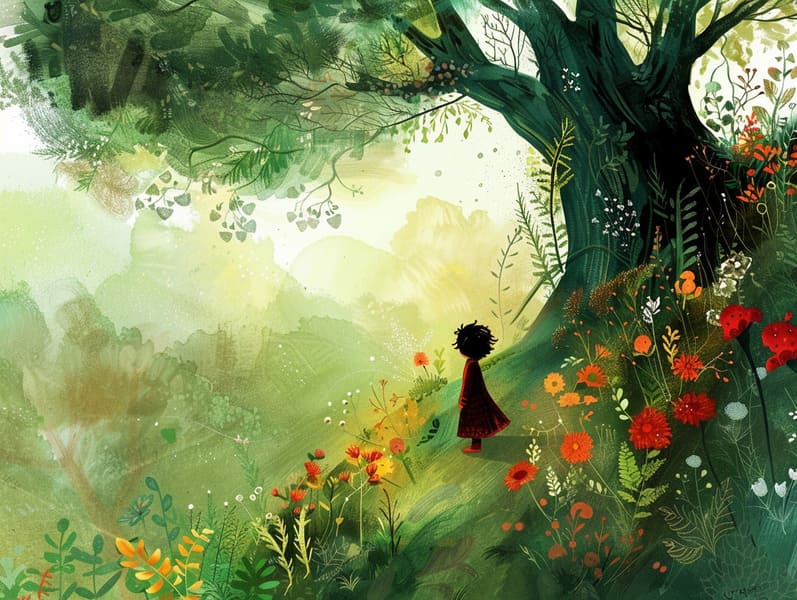
Famous fairy tales have legendary status. These narratives have been spoken from one generation to the next far before they were ever documented. They arose from a variety of backgrounds, including Asian traditions. They were initially told among elders, often carrying themes and messages relevant to the societal norms and beliefs of the time.
Jacob and Wilhelm Grimm, the two Grimm brothers, were among the first to compile many of these beloved stories. Their published works, "Grimm's Fairy Stories," included classics like "The True Bride," "Little Brother and Little Sister," and "Snow White," which have since become essentials in the world of famous fairy tales. Similarly, H. C. Andersen's whimsical narratives, such as "The Little Mermaid," and "The Duckling's Story," have won hearts worldwide, securing their place in the pantheon of classic fairy tales.
Despite their age, fairy tales remain as significant as ever, especially as bedtime stories for kids. These charming stories are now available in diverse formats, including colorful picture books, charming animations, and free fairy tales online.
Their persistent charm can be ascribed to several delightful features:
Moral Lessons: Ancient fairy tales often impart important moral lessons. Tales like "The Story of the Boy Who Cried Wolf" teach the significance of honesty, while "The Hare and the Tortoise" demonstrate the merits of resolve and unassuming nature. These stories offer kids clear distinctions between ethical and unethical, developing their moral compass in a soft yet deep way.
Compassion and Insight: Classic fairy tales frequently illustrate figures facing challenges and struggles, inciting readers to comprehend with their struggles and encourage their triumphs. For instance, "Beauty and the Beast" shows us the benefit of seeing beyond looks to appreciate the inner self of a soul, promoting perception and awareness.
Cultural Awareness: Many old fairy tales are infused with the cultural contexts from which they arose. Exploring these stories can provide fascinating glimpses into different social structures, cultivating a sense of world appreciation and discernment.
Inventiveness and Fantasy: The fanciful elements in ancient fairy tales—magical kingdoms—enliven children’s creative dreams. These fairy tales take readers to fantastical realms, revitalizing fantasy dreams and a sense of amazement that continues a lifetime.
Ancient fairy tales are not only spellbinding but also edifying. They act as bewitching tools in advancing various thinking and feeling skills in the young. When old fairy tales are narrated, they nurture language development by introducing new language items and complicated sentence structures. This practice also improves listening skills and focus, as children track the narrative, anxious to see what happens next.
Furthermore, exploring the themes and characters of ancient fairy tales can foster intellectual skills and problem-solving abilities. The young are shown to see patterns, foresee events, and catch on to cause and effect. These examinations also encourage the young reveal their thoughts and feelings, contributing to their emotional intelligence.
In today’s information age, the abundance of free fairy tales online has made these fairy tales more available than ever. Online platforms and digital apps make available broad selections of Grimm's fairy tales that can be perused or listened through anytime, anywhere. Fairy tales recited are particularly in demand, providing an enjoyable way for young ones to savor these magical stories. Read-aloud books and read-to-me stories take characters and settings to life, often enhanced by spellbinding musical scores and musical scores that intensify the story adventure.
The timeless charm of old fairy tales lies in their ability to shift to today's society while holding onto their central values. Contemporary revisions of these tales often show more different protagonists and modern settings, making them understandable to today’s audience. However, the fundamental themes of fortitude, generosity, and justice remain unchanged, continuing to reach kids of all ages.
Old fairy tales also offer a sense of familiarity and knownness. They furnish a neat narrative with a unmistakable beginning, middle, and end, often drawing to a close with the culmination of conflicts and the triumph of rightness over wrongness. This uniformity can be relieving for children, rendering a sense of dependability in an unstable world.
Ancient fairy tales continue to bewitch and enlighten new generations, maintaining their radiance and importance in modern society. As children's night stories, they online fairy tales for free feature a perfect blend of charm and understanding, supporting moral values, empathy, and creativity. The prevalence of online storybooks and the well-received status of fairy tales spoken validate that these old stories remain acquirable to new generations.
By preserving and telling these stories, we continue to admire the rich tapestry of human imagination and cultural heritage. Whether you are exploring a vividly illustrated book, experiencing a electronic collection, or listening through an spoken story, the grace of classic fairy tales is always within reach. These tales remind us of the steadfast magic of narratives and its ability to link us across time and space.
No matter if you are perusing a vibrantly illustrated book, exploring a web collection, or hearing an read-aloud story, the charm of ancient fairy tales is always within reach.
These tales convey of the unceasing force of tales and its ability to gather us across eras and regions, casting a charm that enchants and educates alike.